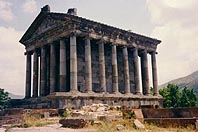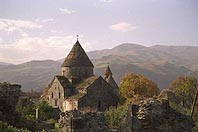by Chalerm Raksanti
Present day Armenia occupies a fraction of the ancient Armenia, which once extended from the lesser Caucasus Mountains, across the plateau to the Taurus
Mountains. For centuries, the Armenians were subjected to warfare against invaders - Assyrians, Romans, Byzantines, Parthians, Arabs and Turks.
 Pagan Temple at Garni
Pagan Temple at Garni
This is an old land. Archaeology extends the history of Armenia to the Acheulian Age of 500,000 years ago. Geography played a key role in the history and
culture of this region. Forming a highway of value for trade and commerce between Asia and Europe, Armenia was destined to remain in the grip of adversity. The land, with its
untold riches and its position of primary import, stirred ambitions of the various powers throughout the ages.
As part of the Persian Empire, Armenia was divided into provinces supervised by Persians. With the fall of Persia’s empire, Alexander The Great from
Macedonia rolled across Europe and Asia, swallowing Armenia in his path. After his sudden death in 323 B.C., Hellenistic culture reigned here as Armenia was spilt into three
kingdoms. The renaissance of Armenia was accomplished under Tigran the Great, and Armenia grew to a great military power around 95-99 B.C. Unfortunately, the vicissitudes of the
people continued to ebb and flow. Sometimes they enjoyed autonomy, and at other points in their long history, they were reduced to the status of mere vassals.
 Sanahin Monastery, Armenia
Sanahin Monastery, Armenia
Twelve years before the Roman Empire issued an edict of tolerance to Christianity, Armenia became the first Christian state through the auspices of King
Tiridates III. The conversion to Christianity was to bring complications, since it awakened anxieties in neighbouring Persia, and later in the Ottomans of Turkey. During the 19th century, Armenians suffered from discrimination, heavy taxes, and armed attacks from the Turks. In the spring of 1909, an orgy of bloodshed took place and
30,000 Armenians lost their lives after a desperate resistance. After the fall of the Soviet Union, Armenia is now an autonomous nation with its own government.
More than 2,800 years old (one of the world’s oldest cities), Yerevan is the capital of Armenia and the centre of its culture. Echmiadzin is a city of
ancient monuments, and the seat of the Armenian Church. Ancient cathedrals and monasteries are found throughout this mountainous country which is filled with magnificent examples
of the lasting influence of religion. The pagan Temple of the Sun at Garni is an outstanding monument of Hellenistic form. Once a summer residence of Kings, it originally stood
within a fortress. And within an hour’s drive of the capital city visitors will find the 13th century monastic cave complex of Geghard. Roaming through
the cathedral, chapels and monk cells which were cut into solid rock, one sees how the prosecution of Christians gave rise to such ingenuity and beauty.